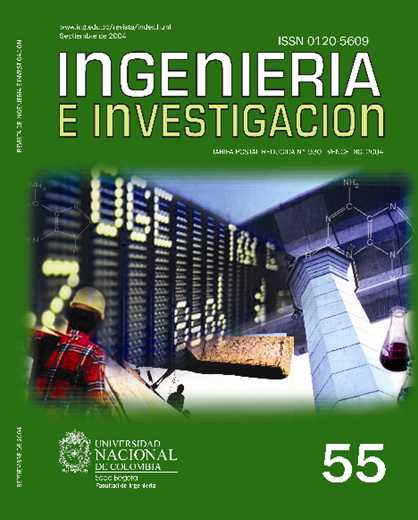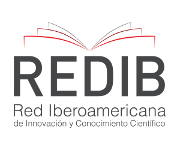Oxidation of H2 and CO in a fuel cell with a Platinum-tin Anode
Oxidación de H2 y CO en una celda de combustible con ánodo de platino-estaño
DOI:
https://doi.org/10.15446/ing.investig.v24n2.14600Keywords:
fuel cell, platinum-Tin anode, CO tolerance (en)celda de combustible, ánodo de platino-estaño, tolerancia al CO (es)
Downloads
This report describes the construction and evaluation of a fuel cell with a bi-metallic anode of Pt-Sn supported on carbon, as catalysts for oxidation of pure hydrogen, pure CO and a 2% CO in H2 mixture. Both, cathode and anode were made with a structure composed by a diffusive layer and a catalytic layer. The diffusive layer was made with a carbon cloth while the catalytic layer contained the platinum and tin supported on carbon. To test the performance of the catalytic mixture, a proton exchange membrane fuel cell (PEMFC) was developed with an original design for the gas distribution plates. The reactants were feed to ambient temperature and 3 psig in the anode side, while 5 psig pure oxygen was used in the cathode. The anode catalytic load was 0.57 mg/cm2 of platinum and 0.08 mg/cm2 of tin. The catalytic load in cathode was 0.85 mg/cm2 of pure platinum. It was found that this catalytic mixture is tolerant to CO presence.
En este trabajo se describe la construcción y evaluación de una celda de combustible con un ánodo bimetálico de Pt - Sn soportado en carbón, como catalizador para la oxidación de hidrógeno puro, CO puro y una mezcla de 2% (v/v) de CO en H2. Tanto el cátodo como el ánodo se construyeron con una estructura compuesta de una capa difusiva y una capa catalítica. La capa difusiva se fabricó con una tela de grafito y la capa catalítica contiene el platino y el estaño soportados sobre carbón. Para evaluar el desempeño de la mezcla catalítica, se construyó una celda de combustible de membrana de intercambio protónico (PEMFC), con un novedoso diseño de placas interdigitadas distribuidoras de gas. Los reactivos se suministraron a temperatura ambiente y a una presión de 3 psig para el ánodo y de 5 psig para el cátodo, al cual se le suministró oxígeno puro. La carga de catalizador en el ánodo fue de 0.57 mg/cm2 en platino y de 0.08 mg/cm2 en estaño, mientras que la carga catalítica en el cátodo se mantuvo en 0.85 mg/cm2 de platino puro. Se encontró que esta mezcla catalítica presenta tolerancia al CO.
References
Divisek, J., H. F Oetjen, V. Peinecke, V.M. Schmidt and U. Stimming, “Components for PEM fuel cell systems using hydrogen and CO containing fuels”, Electrochim. Acta 43, 3811-3815, 1998. DOI: https://doi.org/10.1016/S0013-4686(98)00140-6
Gasteiger, H. A., N. Markovic and P.N. Ross., “H, and CO Electro oxidation on Well-Characterized Pt, Ru, and Pt-Ru. 2. Rotating Disk Electrodes Studies of CO/H2 Mixtures at 62°C”, J. Phys. Chem, 99, 16757-16767, 1995. DOI: https://doi.org/10.1021/j100045a042
Gotz, M. and H. Wendt, “Binary and ternary anode catalyst formulations including the elements W, Sn and Mo for PEMFCs operated on methanol or reformatted gas”, Electrochim, Acta 43, 3637-3644, 1998. DOI: https://doi.org/10.1016/S0013-4686(98)00121-2
Grgur, B., N. Markovic and P.N. Ross. Electro oxidation of H2. CO and H2/CO mixtures on a well-characterized Pt- Re bulk alloy electrode and comparisons with other Pt binary alloys”, Electrochim, Acta 43, 3631-3635, 1998. DOI: https://doi.org/10.1016/S0013-4686(98)00120-0
Mclean, N., M. Jilali and T. Whale, “Application of micro-scale techniques to fuel cell systems design”, 10th canadian hydrogen conference, 17-20, 2000.
Orozco, F y J. E. Orrego, “Estudio de la cinética electroquímica de oxidación de metanol. Electrodo para una celda de combustible”, tesis Universidad Nacional de Colombia - Sede Medellín, 1996.
Passalacqua, E., F Lufrano, G. Squadrito, A. Patti and L. Giorgi, “Nation content in catalyst layer of polymer electrolyte fuel cells: effects on structure and performance”, Electrochim, Acta 46, 799-805, 2001. DOI: https://doi.org/10.1016/S0013-4686(00)00679-4
Pyle, W., A. Spivak, R. Cortez; and J. Healy, “Making electricity with hydrogen”, Home power 35, 1-5, 1993.
Qi, Z. and A. Kaufman, “Activation of low temperature PEM fuel cells”, J. Power Sources, 111, 181-184, 2002. DOI: https://doi.org/10.1016/S0378-7753(02)00273-2
Qi, Z. and A. Kaufman, “Quick and effective activation of proton-exchange membrane fuel cells”, J. Power Sources, 114, 21-31, 2003. DOI: https://doi.org/10.1016/S0378-7753(02)00587-6
Cuireanu, M., H. Wang, and Z. Qi, “Electrochemical impedance study of membrane-electrode assemblies in PEM fuel cells. II. Electrooxidation of H, and H2/CO mixtures on Pt/Ru based gas-diffusion electrodes”, J. Phys. Chem. B., 103, 9645-9657, 1999. DOI: https://doi.org/10.1021/jp9918407
How to Cite
APA
ACM
ACS
ABNT
Chicago
Harvard
IEEE
MLA
Turabian
Vancouver
Download Citation
License
Copyright (c) 2004 Javier González, Carlos Sánchez, Bibian Alonso Hoyos, Carlos Monsalve, Gonzalo Trujillo

This work is licensed under a Creative Commons Attribution 4.0 International License.
The authors or holders of the copyright for each article hereby confer exclusive, limited and free authorization on the Universidad Nacional de Colombia's journal Ingeniería e Investigación concerning the aforementioned article which, once it has been evaluated and approved, will be submitted for publication, in line with the following items:
1. The version which has been corrected according to the evaluators' suggestions will be remitted and it will be made clear whether the aforementioned article is an unedited document regarding which the rights to be authorized are held and total responsibility will be assumed by the authors for the content of the work being submitted to Ingeniería e Investigación, the Universidad Nacional de Colombia and third-parties;
2. The authorization conferred on the journal will come into force from the date on which it is included in the respective volume and issue of Ingeniería e Investigación in the Open Journal Systems and on the journal's main page (https://revistas.unal.edu.co/index.php/ingeinv), as well as in different databases and indices in which the publication is indexed;
3. The authors authorize the Universidad Nacional de Colombia's journal Ingeniería e Investigación to publish the document in whatever required format (printed, digital, electronic or whatsoever known or yet to be discovered form) and authorize Ingeniería e Investigación to include the work in any indices and/or search engines deemed necessary for promoting its diffusion;
4. The authors accept that such authorization is given free of charge and they, therefore, waive any right to receive remuneration from the publication, distribution, public communication and any use whatsoever referred to in the terms of this authorization.



























